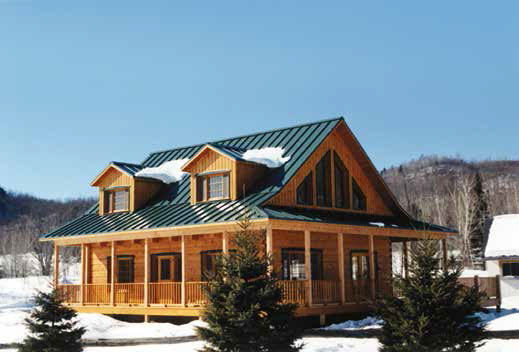Asphalt shingles are still the norm in most regions, but the next roof over your head could be an energy-saving metal one made of stainless steel and painted to reflect hot sun rays. Thomas Jefferson chose metal roofing to shelter Monticello, his Virginia estate. Centuries later, historians say, Jefferson’s “tin” roof “is in fine shape.”
That kind of durability, say metal roofing retailers and manufacturers, is a strong selling point to a growing band of homeowners who want a building material that is not only sustainable, energy efficient, and cost-effective, but more aesthetically pleasing than asphalt. Today, consumers can select metals from copper to zinc, and roofing styles ranging from traditional vertical seams to those resembling wood shake, slate, shingles, and clay tiles. A multi-year study conducted by the Oak Ridge National Laboratory’s Building Technology Center suggests that replacing conventional asphalt roofs with metal ones can reduce air conditioning energy use by up to 25 percent.
If you’re wondering whether your house should be clad with a metal roof, ENERGY STAR® offers this guidance: homes that are hampered with high air-conditioning bills, have large roof surfaces, lower insulation levels, or located in hot, sunny climates benefit the most from metal roofing. Painted metal roofs, also known as “cool metal roofs,” are designed to reflect more sunlight and absorb less heat than a standard roof. Special reflective color pigments make this possible. Whether white or a darker paint color is used, heat will still reflect well and help reduce cooling loads in summer and insulate homes in winter.
With metal roofs, there are additional ways for homeowners to save money over time, but the initial purchase price can be a factor. The cost for using metal roofing systems in home renovations or new residential construction is higher than most other materials, manufacturers say. But compared to traditional, dark gray asphalt shingles and other non-metal roofs that last an average of 17 years and require replacing about every decade or two, metal roofs last longer. A metal roof lifespan is about two to three times longer, says William “Bill” Hippard, chair of the nonprofit Metal Roofing Alliance, a coalition that educates consumers about the benefits of modern metal roofing, and the product is virtually maintenance-free.







This is the best project for residential owners who want to minimize their electricity expenses. They can also easily avail the benefits of having solar panels installed in their home.
Comments are closed.